WorldView-2
EO
Operational (nominal)
Digital Globe
Maxar
Launched October 2009, WorldView-2 (WV-2) is a commercial imaging satellite, owned and operated by Maxar Technologies Inc., formed by a merger between MDA (MacDonald Dettwiler and Associates) Holdings Company, and DigitalGlobe Inc., that provides high spatial resolution imagery of the Earth’s surface for commercial purposes. It is the successor to WorldView-1 (WV-1) and aims to meet the increasing demand for high spatial resolution imagery.
Quick facts
Overview
| Mission type | EO |
| Agency | Digital Globe, Maxar |
| Mission status | Operational (nominal) |
| Launch date | 08 Oct 2009 |
| Instruments | WV-110 |
| CEOS EO Handbook | See WorldView-2 summary |
Related Resources
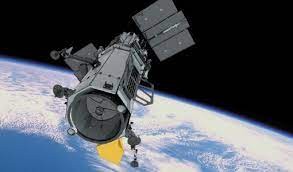
Summary
Mission Capabilities
WV-2 carries a single sensor, the WorldView-110 camera (WV110), a nine channel VIS/NIR (Visible/Near Infrared) radiometer and high resolution optical imager. The instrument aims to provide very high resolution panchromatic imagery and eight band multispectral imagery for alternative mapping and monitoring applications. The WV110 imager uses a pushbroom scanning technique.
Performance Specifications
WV110 operates in two channels, an eight band multispectral (MS) channel, and a panchromatic channel. The MS channel has four standard colour bands (blue, green, yellow, red) and four additional colour bands (coastal blue, red edge, NIR (near-infrared) 1, NIR 2), with spectral range of 400 nm - 1050 nm. When performing MS imaging, the WV110 imager has a spatial resolution of 1.8 m GSD (Ground Sample Distance) at nadir (2.4 m at 20° off-nadir). The panchromatic channel has a spectral range of 450 nm - 800 nm, and spatial resolution of 0.46 m GSD at nadir (0.52 m at 20° off-nadir). The imager has a swath width of 16.4 km, Field of View (FOV) of greater than 1.28° and a geolocation accuracy of less than 3 m without any GCP (Ground Control Points) across both channels.
WV-2 operates in a sun-synchronous near-circular orbit of altitude 767 km. It has an inclination of 97.8°, a period of 100.2 minutes, and its LTDN (Local Time on Descending Node) is at 1030 hours. WV-2 has outlasted its expected design life of 7.25 years, remaining operational as of December 2024.
Space and Hardware Components
WV-2 uses an identical bus to WV-1, the BCP-5000 (Ball Commercial Platform 5000), developed by Ball Aerospace and Technologies Corporation (BATC), which also supplied the WV60 and WV110 imagers. The satellite bus has dimensions 3.6 m (height) x 2.5 m (diameter) and a launch mass of 2500 kg. The ADCS (Attitude Determination and Control Subsystem) consists of star trackers, SIRUTM (Spatial Inertial Reference Unit - scalable) of Northrop Grumman and GPS for attitude sensing as well as CMGs (Control Moment Gyroscopes) for actuators. This allows a body pointing range of ±40° about nadir with instantaneous pointing accuracy of less than 500 m, and provides a retargeting rate of 3.5°/s, with acceleration 1.5°/s2. Image and ancillary data are transmitted at 800 Mbit/s in X-band, while command data is transmitted at 64 kbit/s in S-band. The spacecraft has an onboard storage capacity of 2.2 Tbit in solid state with EDAC (Error Detection and Correction).
WorldView-2
Spacecraft Launch Mission Status Sensor Complement References
WorldView-2 (WV2) is a commercial imaging satellite of DigitalGlobe Inc. of Longmont, CO, USA (follow-on spacecraft to WorldView-1). The overall objective is to meet the growing commercial demand for high-resolution satellite imagery (0.46 cm Pan, 1.8 m MS at nadir - representing one of the highest available spaceborne resolutions on the market).
In the autumn of 2003, DigitalGlobe had received a contract from NGA (National Geospatial-Intelligence Agency) of Washington DC to provide high-resolution imagery from the next-generation commercial imaging satellites. The contract award was made within NGA's NextView program. The NGA requirements called for imagery with a spatial resolution of 0.5 m panchromatic and 2 m MS (Multispectral) data. 1)
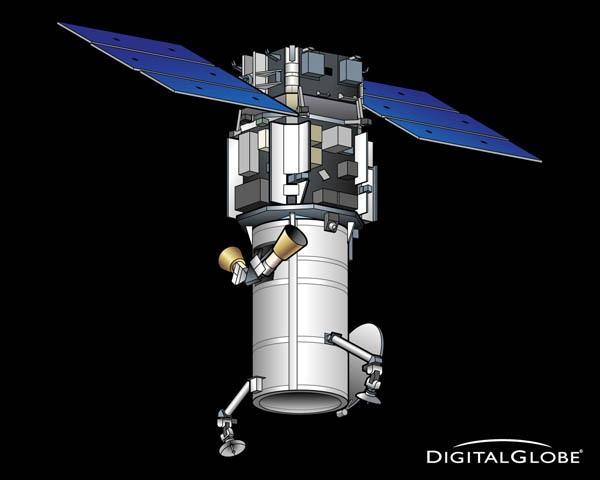
Spacecraft
Like its Worldview-1 predecessor, the WorldView-2 spacecraft is being manufactured at BATC (Ball Aerospace and Technologies Corporation) of Boulder, CO which was awarded a contract in late 2006. BATC is providing its BCP 5000 (Ball Commercial Platform 5000) spacecraft bus for WorldView-2 and will integrate the remote sensing instrument onto the bus ( with WorldView-2, a larger imaging payload is being mounted onto the same spacecraft bus as that used for WorldView-1). A new vibration isolation system is being used on WorldView-2 for the payload to control jitter induced by the spacecraft. The BCP-5000 bus provides state-of-the-art power, stability, agility, data storage and data transmission (over the BCP-2000 bus). 2) 3) 4)
The spacecraft is 3-axis stabilised. The ADCS (Attitude Determination and Control Subsystem) employs star trackers, SIRUTM (Space Inertial Reference Unit- scalable) of Northrop Grumman, and GPS for attitude sensing, and CMGs as actuators for highly responsive pointing control. A spacecraft body-pointing range of ±40º about nadir is provided corresponding to a FOR (Field of Regard) of 1355 km in cross-track. An instantaneous geolocation accuracy of ≤ 500 m is provided at any start and stop of an imaging sequence. With its improved agility, WorldView-2 acts like a paintbrush, sweeping back and forth to collect very large areas of multispectral imagery in a single pass. WorldView-2 alone has a collection capacity of 975,000 km2/day. The combination of WorldView-2's increased agility and high altitude (770 km) enables it to typically revisit any place on Earth in 1.1 days.
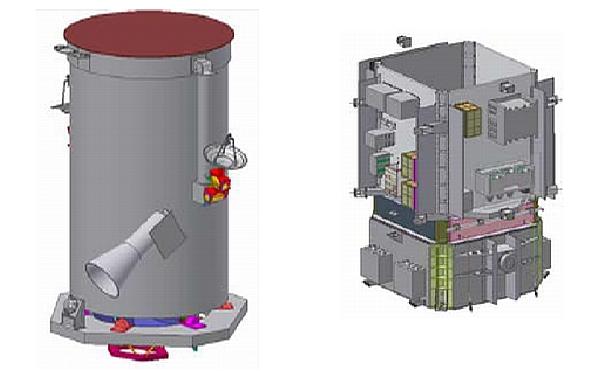
The QuAD (Quiet Array Drive) motion control technology of Starsys Inc. is being used to articulate the solar arrays. The low disturbance implementation permits imaging observations to be conducted in parallel to the array articulation task.
A single-board BAE Systems RAD750 radiation-hardened computer manages the data processing command and control functions for WorldView-2.
S/C bus type | BCP-5000 |
S/C stabilisation | - 3-axis stabilised using star trackers and solid-state IRU for sensing |
Pointing accuracy | - Accuracy: <500 m at image start and stop |
FOR (Field of Regard) | 1355 km in cross-track (nominally ±40º off-nadir body pointing capability |
S/C bus size | 4.3 m (height) x 2.5 m (diameter), 7.1 m span width (deployed) |
S/C launch mass, power | 2800 kg, 3.2 kW (EOL, 100 Ah NiH2 battery) |
Mission design life | 7.25 years |
Onboard data storage | 2.2 Tbit in solid-state memory with EDAC (Error Detection and Correction) |
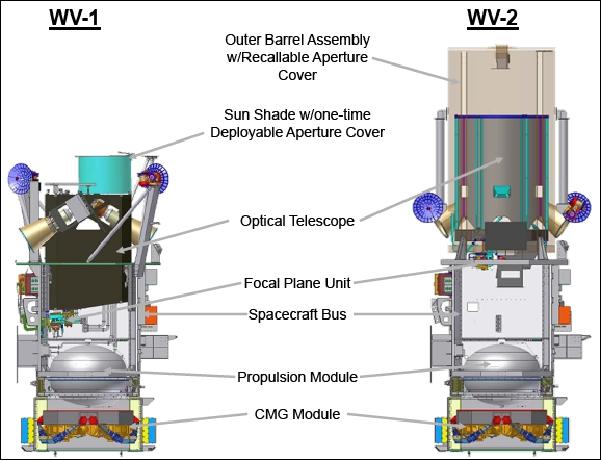
The advanced CMGs (Control Moment Gyroscopes) provided by Ball Aerospace for WorldView-2, as well as for DigitalGlobe's WorldView-1, afford the satellites the flexibility to capture more imagery than ever before. This high-performance technology provides acceleration up to 10 times that of other attitude control actuators and improves both maneuvering and targeting capability, while reducing slew time from over 60 seconds to only 9 seconds to cover 300 km. This means WorldView-2 will be able to rapidly swing precisely from one target to another, allowing extensive imaging of many targets, as well as stereo, in a single orbital pass.
BATC used the M-95 CMG configuration for the WorldView-1 and WorldView-2 spacecraft providing a torque of up to 6.1 Nm. The M-95 CMG configuration has a total mass of 261.6 kg (including isolation mounts and electronics) and a power consumption of 220 W. 5)
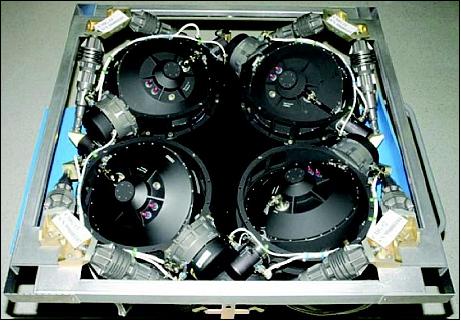

RF communications: The command data are in S-band at 2 or 64 kbit/s. The housekeeping telemetry and tracking is being done in X-band at 4, 16, or 32 kbit/s of real-time data, or 524 kbit/s of stored data. The imagery is downlinked in X-band at 800 Mbit/s (dual polarisation). The spacecraft provides a data storage capacity of 2.2 Tbit in solid state memory with EDAC (Error Detection and Correction). A total of 331 Gbit of imagery per orbit may be collected.
In addition, direct (real-time) downlinks to customer sites are available using the same high-speed 800 Mbit/s X-band link.
Launch
Launch: The WorldView-2 spacecraft was launched on October 8, 2009 on a Delta 7920 vehicle of ULA (United Launch Alliance) from VAFB, CA. ULA provided the services for this mission on behalf of BLS (Boeing Launch Services). 7) 8)
Orbit: Sun-synchronous nearly circular orbit, altitude = 767 km, inclination = 97.8º, period = 100.2 minutes, LTDN (Local Time on Descending Node) is at 10:30 hours.
Mission Status
• June 26, 2019: Satellite photos supplied by Maxar of before and after reveal a dramatic explosion, and subsequent fire, of an ammunition depot in Arys, Kazakhstan that killed two, injured at least 46 and required the forced evacuation of tens of thousands. 9) Maxar captured satellite imagery on June 24, showing extensive damage from an ammunition depot explosion near Arys, Kazakhstan. The blast scattered burning debris across fields and into the nearby city. Small fires were still visible within the destroyed depot, though the cause remains unknown. The explosion occurred at around 9:20 a.m. after a fire broke out at the military base, according to Kazakhstan's Emergency Situations Committee. This marks the fourth such incident in the Turkestan region in a decade. The governor of Turkestan declared a state of emergency and ordered the evacuation of Arys’ 45,000 residents.
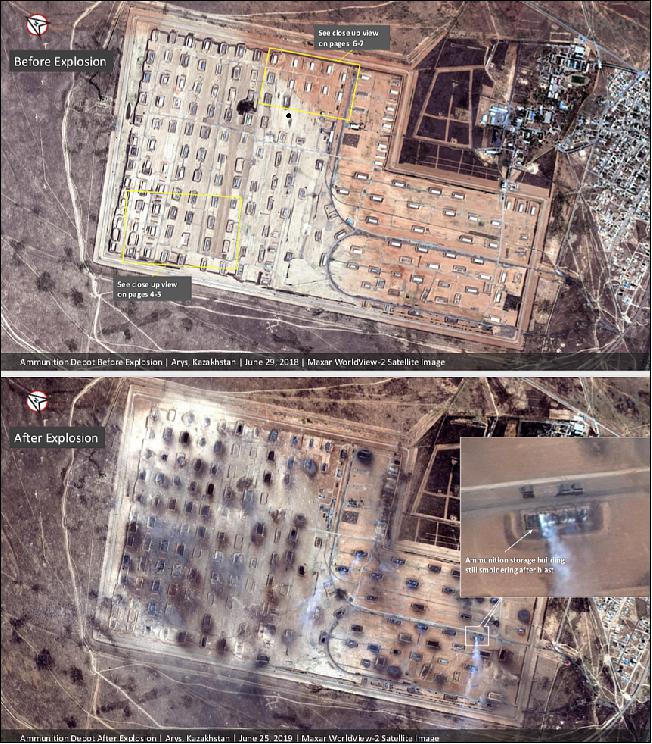
• March 20, 2019: The right combination of ample rain from December and stable cooler temperatures arrived in Walker Canyon, which is about 50 miles southeast of Los Angeles. This triggered a "super bloom" of orange poppy flowers that the area typically sees only once every 10 years. 10) Hordes of tourists then descended upon the nearby city of Lake Elsinore, filling the roads with traffic and covering the hillsides with people. In space, the bursts of orange colour — and miles' worth of cars — are so dense that the WorldView-2 satellite owned by DigitalGlobe easily spotted the scene from about 480 miles (770 km) above the planet.
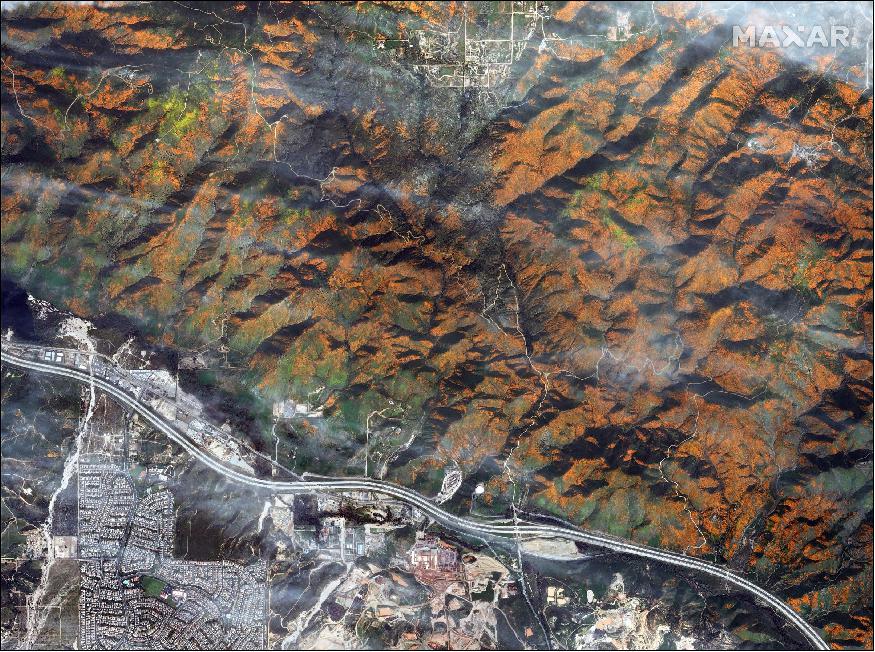

• 2017: The WorldView-2 spacecraft was operational in its 8th year on orbit. 13) 14) DigitalGlobe released the below WorldView-2 image to commemorate the ULA (United Launch Alliance) Atlas 5 blasting off with WorldView-4 on November 11, 2016 from Vandenberg Air Force Base, California.
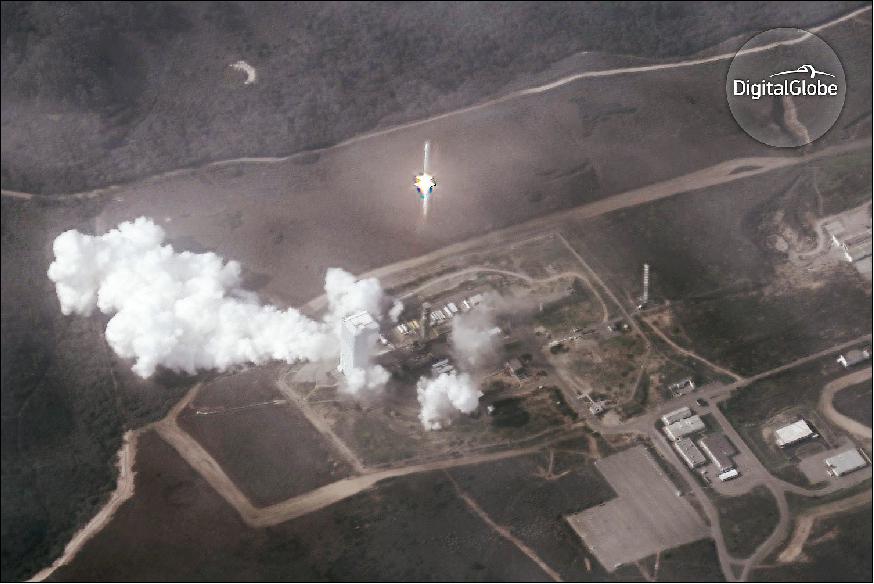
• July 19, 2016: According to the USAF (US Air Force), a DigitalGlobe imagery satellite was involved in what has been described as a debris-causing event. DigitalGlobe released an hours-old photo of Oakland, CA on July 19 (Figure 10), hoping to squash questions about the operability of one of its high-resolution imagery satellites after the U.S. Air Force said it had been part of a debris-causing event earlier in the day. 15) JSpOC (Joint Space Operations Center), which is the Defense Department's nerve center for space operations and tracks space objects from Vandenberg Air Force Base in California, identified a debris-causing event related DigitalGlobe's WorldView-2 satellite.
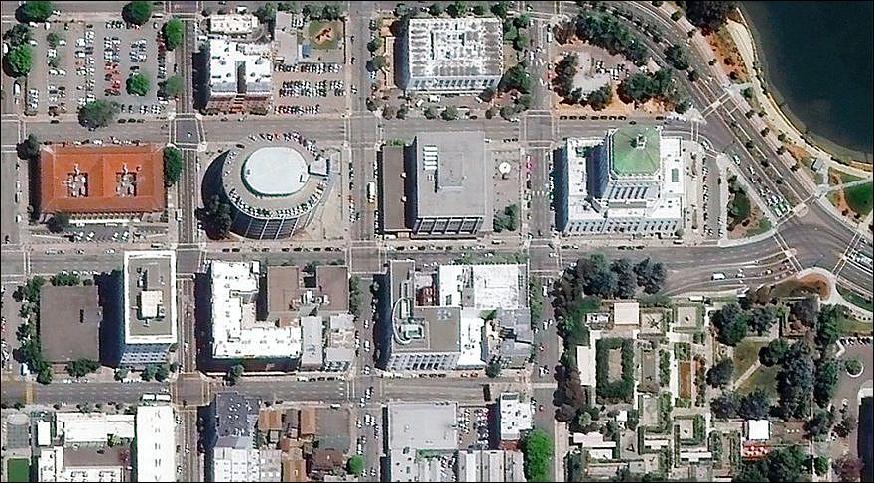
• December 3, 2015: Mount Etna erupted just after 2 UTC for the first time since May 2015. The upwards jet of lava from the Voragine crater lasted for 50 minutes sending an ash plume more than 3 km high. The fountain of lava reached 1 km above the crater. This was the biggest eruption since September 1999 when the volcano shot volcanic material more than 12 km high. 16) Etna is the tallest and largest volcano of Europe and has four summit craters. Its eruptions occur both at the top and from its sides down to a few hundred meters above the sea-level. It is one of the most active volcanoes on the Earth so is continuously monitored by the Etna Observatory based in Sicily.
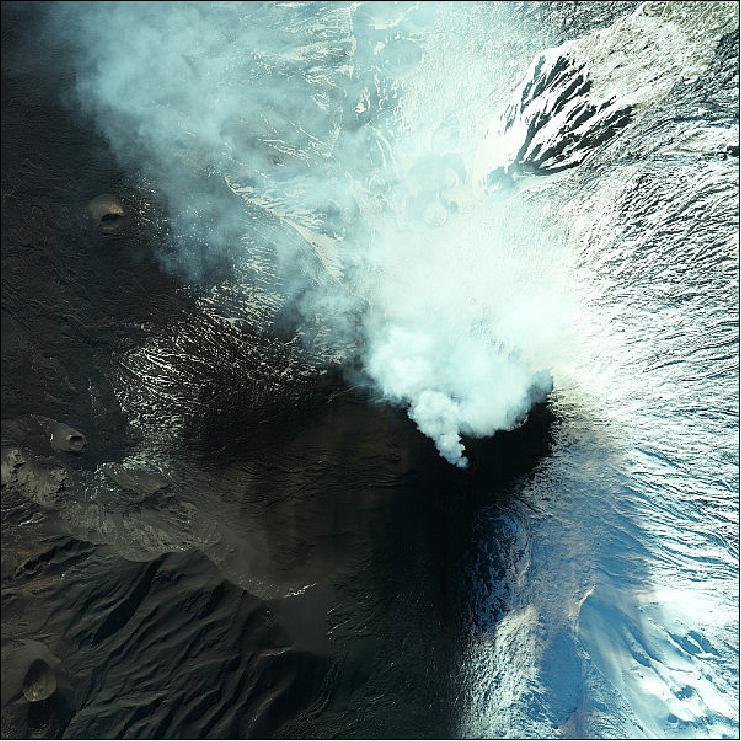
• 2014: The WorldView-2 spacecraft and its payload were operating nominally, in its 5th year on orbit.
Parameter | Ikonos-2 | QuickBird-2 | WorldView-1 | GeoEye-1 | WorldView-2 | WorldView-3 | GeoEye-2 |
Spectral characteristics | Pan+4 MS | Pan+4 MS | Pan | Pan+4 MS | Pan+8 MS | Pan+8 MS +8 SWIR | Pan+4 MS |
Panchromatic resolution (nadir) | 0.82 m | 0.55 m | 0.50 m | 0.41 m | 0.31 m | 0.31 m | 0.31 m |
Multispectral resolution (nadir) | 3.28 m | 2.20 m | N/A | 1.64 m | 1.84 m | 1.24 m | 1.24 m |
Accuracy specification (nadir) | 9 m CE90 | 23 m CE90 | 4 m CE90 | 3 m CE90 | 3.5 m CE90 | 3.5 m CE90 | 3.5 m CE90 |
Onboard storage capacity | 80 Gbit | 128 Gbit | 2199 Gbit | 1000 Gbit | 2199 Gbit | 2199 Gbit | 3000 Gbit |
Collection capacity/day | 150,000 km2 | 160,000 km2 | 1,500,000 km2 | 350,000 km2 | 1,200,000 km2 | 680,000 km2 | 680,000 km2 |
Launch date | Sept. 24, 1999 | Oct. 18, 2001 | Sept. 18, 2007 | Sept. 06, 2008 | Oct. 08, 2009 | Aug. 13, 2014 | 2016 |
• November 2013: Typhoon Haiyan, also known as Typhoon Yolanda in the Philippines, was a powerful tropical cyclone that devastated portions of Southeast Asia, particularly the Philippines, on November 8, 2013. It is the deadliest Philippine typhoon on record, killing at least 6,268 people in that country alone. Haiyan is also the strongest storm recorded at landfall, and unofficially the strongest typhoon ever recorded in terms of wind speed. 23) There was widespread devastation from the storm surge in Tacloban City especially in San Jose, with many buildings being destroyed, trees knocked over or broken, and cars piled up. The low-lying areas on the eastern side of Tacloban city were hardest hit, with some areas completely washed away (90%of the city had been destroyed) . Flooding also extended for 1 km inland on the east coast of the province. The WorldView-2 spacecraft observed the region on Nov. 13, 2013 (Figure 12).
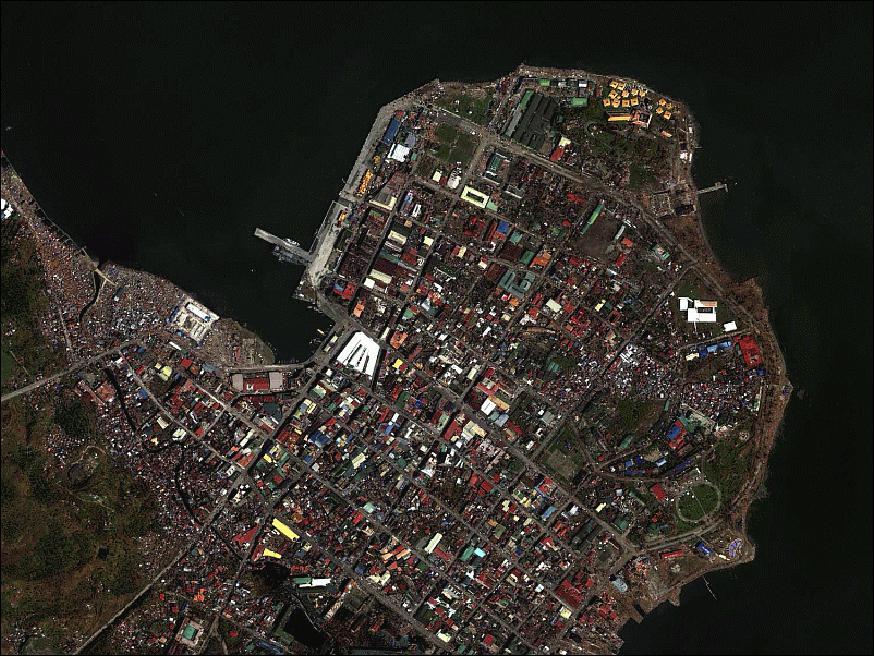
• September 26, 2013: The WorldView-2 spacecraft and its payload are operating nominally in 2013. - The image of Figure 13 was featured on the Earth from Space video program (Earth observation image of the week) of ESA. 24)

• 2012: The WorldView-2 spacecraft and its payload were operating nominally. 25)
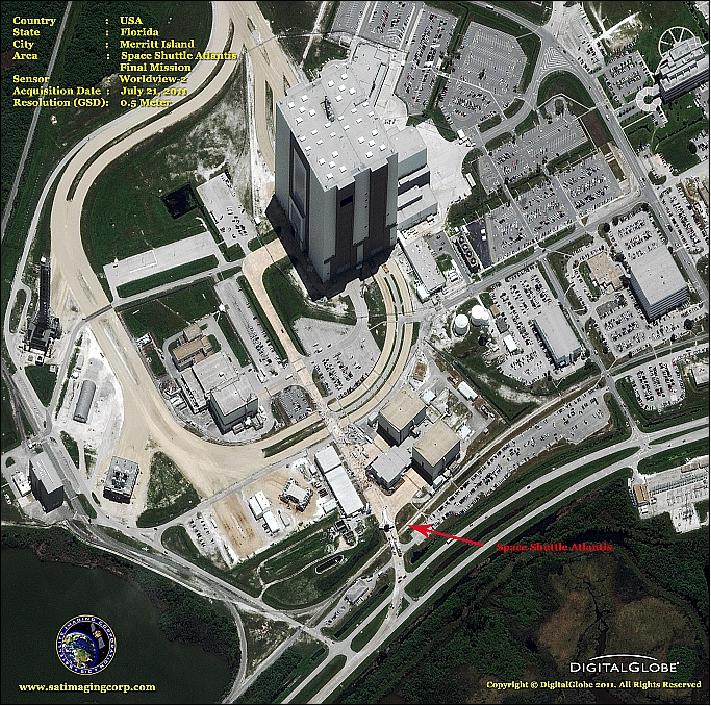
• 2011: The spacecraft and its payload were operating nominally. Figure 15 is an example of the spacecraft's event monitoring capability. DigitalGlobe is supporting this crisis/event monitoring service on a regular basis. 27) 28) WV02 (WorldView-2) had CCAP metrics between 2.4 to 3.5 m at nadir, < 6.5 m. WV02 (WorldView-2) stereo geolocation accuracy components were also within 6.5 m. In September 2010, Aviation Week reported that DigitalGlobe would lower the orbital altitude of the WorldView-2 spacecraft from 770 km to 680 km on request from NGA (National Geospatial-Intelligence Agency). However, there has never been an update about whether this movement actually occured.

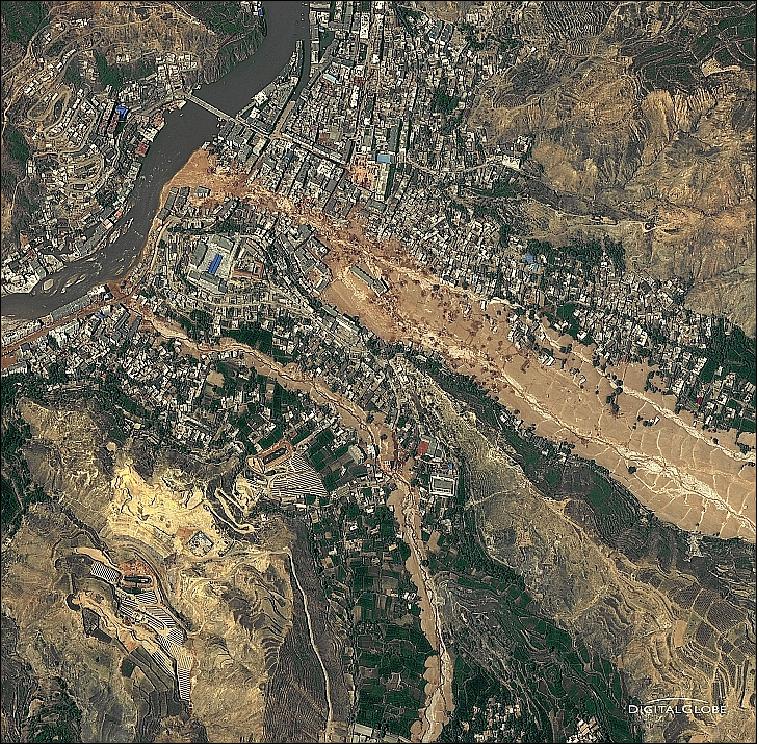
• 2010: The WorldView-2 spacecraft and its payload were operating nominally in 2010. 32) 33) 34)
• January 12, 2010: For the Haiti earthquake disaster DigitalGlobe provided a free-of-charge high-resolution imagery service to aid the extensive relief and recovery efforts.
• January 4, 2010: DigitalGlobe reported that its spacecraft WorldView-2 has achieved full operational capability and that its imagery is now commercially available. The DigitalGlobe ground station received a downlink signal confirming that the satellite successfully separated from its launch vehicle and automatically initialised its onboard processors. 35) 36)38)
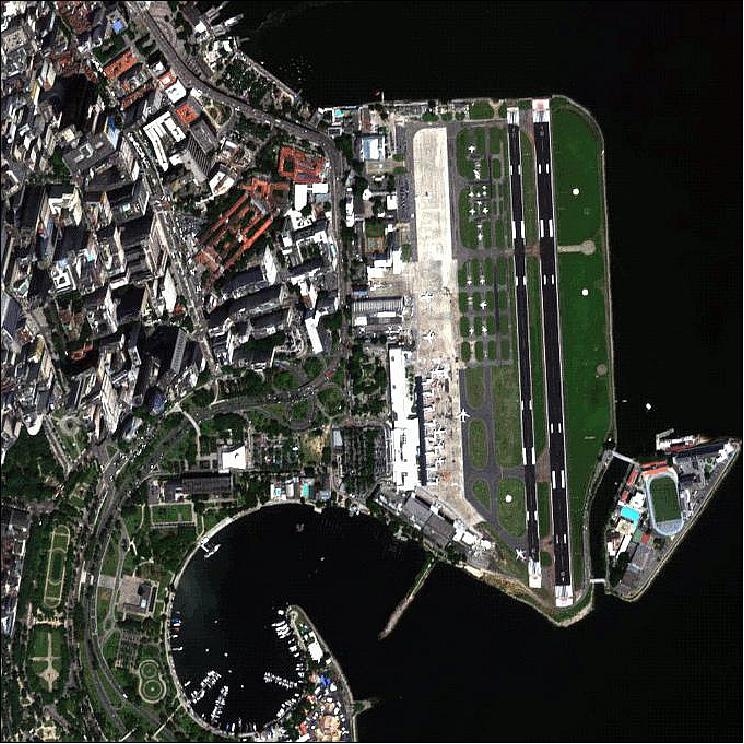
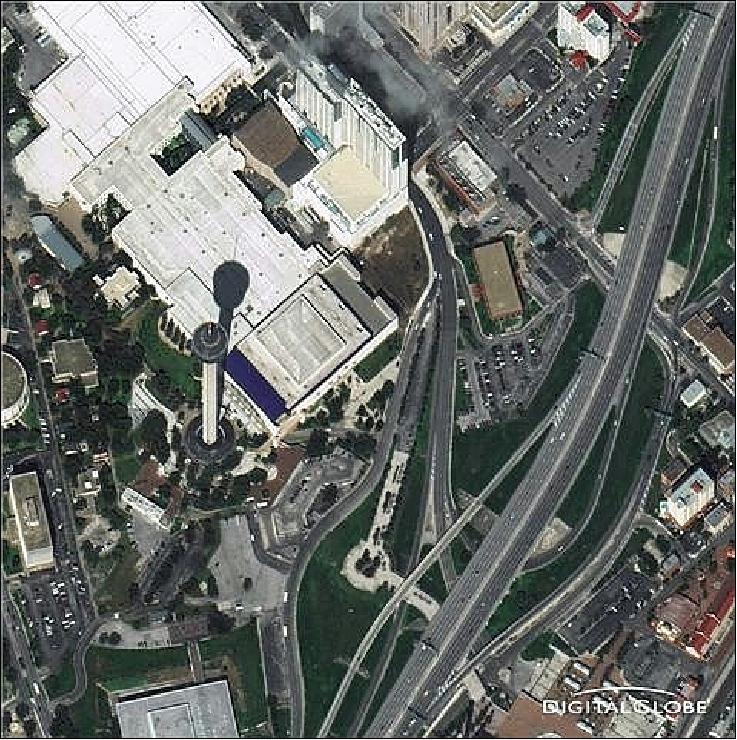
Sensor Complement
WV110 (WorldView-110 camera)
WV110 was designed and developed at ITT Corporation's Space Systems Division of Rochester, NY. The objective of the WV110 instrument is to provide high-resolution panchromatic as well as 8-band multispectral imagery for enhanced mapping and monitoring applications (including stereo imagery due to rapid retargeting capability). 39) 40)
In September 2008, BATC started with the integration of the WV110 camera. On Feb. 24, 2009 the WV110 camera had been integrated into the WorldView-2 spacecraft and system-level testing has commenced. 41) 42) 43) 44)
Imager type | Pushbroom imager (or a line scan imaging system) | |
Imaging mode | Panchromatic (Pan) | Multispectral (MS) 8 bands |
Spectral range | 450-800 nm | 400-450 nm (coastal blue) |
Spatial resolution at nadir | 0.46 m GSD (0.52 m at 20º off-nadir) | 1.8 m GSD (2.4 m at 20º off-nadir) |
Swath width | 16.4 km (multiple adjoining paths can be imaged in a target area in a single orbit pass due to S/C agility) | |
Detectors | Pan: Si CCD array (8 µm pixel size) with a row of > 35,000 detectors | |
Data quantisation | 11 bit | |
Geolocation accuracy of imagery | ≤ 3 m (using a GPS receiver, a gyroscope and a star tracker) without any GCP (Ground Control Points) | |
Optics | TMA telescope with an aperture diameter of 1.1 m, focal length = 13.3 m, f/12 | |
TDI (Time Delay Integration) | 6 selectable levels from 8 to 64 in Pan and MS | |
FOV (Field of View) | > 1.28º | |
Instrument size | 3 m tall | |
Spectral band | Center wavelength (nm) | Minimum lower band edge (nm) | Maximum upper band edge (nm) |
Pan (WorldView-1) imager | 650 | 400 | 900 |
Pan (WorldView-2) imager | 625 | 447 | 808 |
MS1 (NIR1) | 831 | 765 | 901 |
MS2 (red) | 659 | 630 | 690 |
MS3 (green) | 546 | 506 | 586 |
MS4 (blue) | 478 | 442 | 515 |
MS5 (red edge) | 724 | 699 | 749 |
MS6 (yellow) | 608 | 584 | 632 |
MS7 (coastal blue) | 427 | 396 | 458 |
MS8 (NIR2) | 908 | 856 | 1043 |
Parameter / Spacecraft | QuickBird-2 (QB) | WorldView-1 | WorldView-2 |
Launch date | Oct. 21, 2001 | Sept. 18. 2007 | Oct. 08, 2009 |
Orbital altitude (SSO) | 450 km | 450 km | 770 km |
Spacecraft mass at launch | 931 kg | 2500 kg | 2800 kg |
Spacecraft bus size | 3 m x 1.6 m Ø | 3.6 m x 2.5 m Ø | 4.3 m x 2.5 m Ø |
Spacecraft bus type | BCP-2000 | BCP-5000 | BCP-5000 |
Solar array span | 5.2 m | 7.1 m | 7.1 m |
Spacecraft power | 1.14 kW (EOL) single junction GaAs cells | 3.2 kW (EOL) triple junction GaAs cells | 3.2 kW (EOL) triple junction GaAs cells |
Battery | 40 Ah NiH2 | 100 Ah NiH2 | 100 Ah NiH2 |
Attitude actuation | Reaction wheels | CMG assembly | CMG assembly |
S/C body pointing capability | ±30º (nominal in any direction) | ±40º (nominal in any direction) | ±40º (nominal in any direction) |
Onboard propulsion | 4 x 4.4 N hydrazine thrusters | Yes | Yes |
Spacecraft design life | 5 years | 7.25 years | 7.25 years |
RF Wideband downlink | 320 Mbit/s | 800 Mbit/s | 800 Mbit/s |
Onboard data storage | 128 Gbit | 2.2 Tbit | 2.2 Tbit |
|
|
|
|
Payload (builder) | BHRC60 (BATC) | WV60 (ITT) | WV110 (ITT) |
Telescope aperture | 60 cm Ø | 60 cm Ø | 110 cm Ø |
Swath width | 16.5 km | 16.4 km | 16.4 km |
Pan resolution at nadir | 0.61 cm | 50 cm | 46 cm |
MS resolution at nadir | 2.4 m | - | 1.8 m (8 bands) |
Monoscopic area coverage | 1 x | > 4 x | > 4 x |
Single pass mono coverage | 1 strip of 350 km | 1 strip of 650 km | 1 strip of 650 km |
Single pass stereo coverage | Single scene (<10º off nadir track) | 3 strip x 55 km | 3 strip x 55 km |
WorldView-2 is the first commercial satellite to carry a very high spatial resolution 8-band multispectral sensor. Focal planes on the WV2 sensors are enhancements over those used on QuickBird (QB). In addition to overall increased agility, the WV110 focal plane carried by WV2 has a total of one panchromatic and eight multispectral bands with center wavelengths at 425 (coastal blue), 480 (blue), 545 (green), 605 (yellow), 660 (red), 725 (red edge), 835 (NIR1), and 950 (NIR2) nm, respectively. 46)
The new spectral dimensions in WV2 (coastal blue, yellow, rededge, NIR2) target costal and vegetation land cover types with applications in plant species identification, mapping of vegetation stress and crop types, mapping of benthic habitats, wetlands, coast water quality, and bathymetry. The addition of yellow and red edge bands fills important gaps in the spectrum that relate to our ability to capture vegetation phenomenology. The coastal and NIR2 bands extend the spectral coverage to wavelengths where there is increased divergence among the spectral response of vegetation types and many man-made materials. Overall, the broader and continuous coverage, along with sharper multispectral channels provide the potential for more robust modeling and discrimination of spectral signatures.

Mode | PAN line rate | MS line rate | Aggregation | TDI rates | Cmpression levels (bpp) |
A | 24,000 | N/A | PAN= 1 x 1 | PAN= 8, 16, 32, 48, 56, 64 | 2.75, 2.4 |
B | 24,000 | 3,000 | PAN= 1 x1 | PAN= 8, 16, 32, 48, 56, 64 | PAN: 2.75, 2.4 |
C | 20,000 | 5,000 | PAN= 1 x1 | PAN= 8, 16, 32, 48, 56, 64 | PAN: 2.75, 2.4 |
Note: the PAN and MS line rates stated in Table 6 are at pixel level, not at detector level.
The focal plane is comprised of fifty panchromatic staggered DSAs (Detector Sub-Arrays), and two sets of ten MS, staggered DSAs, as shown in Figure 20. The two sets of staggered MS arrays are positioned on either side of the Pan array, one for the MS1 bands (MS1: NIR1, Red, Green, Blue), and the other for the MS2 bands (MS2: RedEdge, Yellow, Coastal, NIR2) . Each DSA contains four parallel rows of detectors, each with a different colour filter. For each DSA, the individual bands are collected by a separate readout register. The Pan array uses two separate readout registers for each of its fifty DSAs. Each readout register has its own analog-to-digital converter.
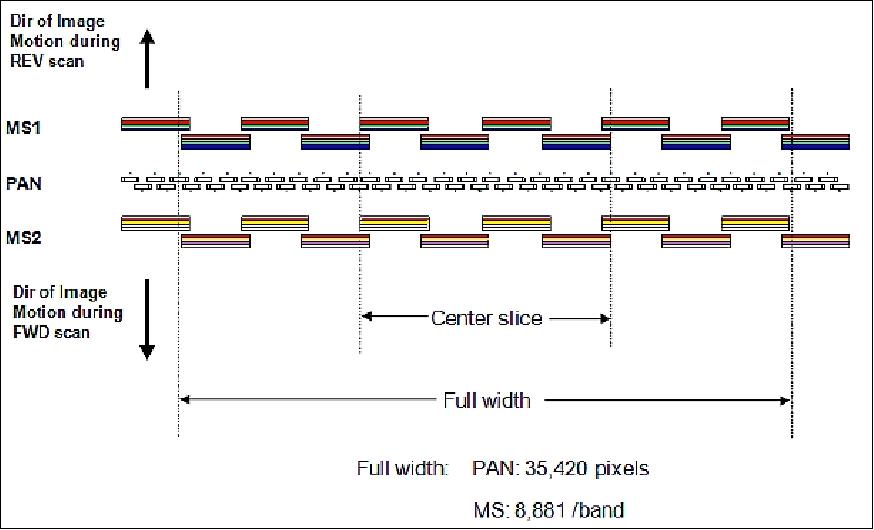


References
1) "Worldview-2 Earth Observation Satellite, USA," URL: http://www.aerospace-technology.com/projects/worldview-2/
2) http://www.ballaerospace.com/page.jsp?page=82
3) http://www.euspaceimaging.com/products/67/
4) "WorldView-2 Media Kit," BATC, URL: http://www.ballaerospace.com/page.jsp?page=211
5) R. C. Hopkins, C.L. Johnson, C. Kouveliotou, D. Jones, M. Baysinger, T. Bedsole, C.D. Maples, P. J. Benfield, M. Turner, P. Capizzo, L. Fabisinski, L. Hornsby, K. Thompson, J. H. Miernik, T. Percy, "Xenia Mission: Spacecraft Design Concept," NASA/MSFC, NASA/TM—2009–216270, Dec. 2009, p. 16, URL: http://ntrs.nasa.gov/archive/nasa/casi.ntrs.nasa.gov/20100019148_2010019690.pdf
6) "Southwest Research Institute (SwRI) 2009 News Release: WorldView-2 satellite features key processing electronics from SwRI," SwRI, Oct. 8, 2009, URL: http://www.swri.org/9what/releases/2009/WorldView2.htm
7) "United Launch Alliance Successfully Launches WorldView-2 Mission for DigitalGlobe & Boeing Launch Services," Oct. 8, 2009, URL: http://www.prnewswire.com/news-releases/united-launch-alliance-successfully-
launches-worldview-2-mission-for-dig
italglobe--boeing-launch-services-63791607.html
8) http://www.floridatoday.com/content/blogs/space/ULA_WorldviewII.pdf
9) "The Big Boom ... Maxar's Satellite Reveals Huge Ammunition Depot Explosion in Kazakhstan," Satnews Daily, 26 June 2019, URL: http://www.satnews.com/story.php?number=699489550
10) Dave Mosher, "Satellites just photographed California's dazzling 'super bloom' of spring flowers from outer space," Business Insider, 20 March 2019, URL: https://www.businessinsider.com/california-superbloom-spring-flowers-space-satellite-pictures-2019-3
11) "MDA Completes Acquisition of DigitalGlobe, Creates Industry Leader in Satellite Systems, Earth Imagery, Geospatial Solutions and Analytics," MDA Press Release, Oct. 5, 2017. URL: https://mdacorporation.com/news/pr/pr2017100509.html
12) Henry Caleb, "MDA closes DigitalGlobe merger, rebrands as Maxar Technologies," Space News, Oct. 5, 2017, URL: http://spacenews.com/mda-closes-digitalglobe-merger-rebrands-as-maxar-technologies/
13) https://twitter.com/DigitalGlobe
14) Justin Ray, "WorldView 4 high-resolution satellite now open for business in space," Spaceflight Now, Feb. 3, 2017, URL: http://spaceflightnow.com/2017/02/03/worldview-4-high-resolution-satellite-now-
open-for-business-in-space/
15) Mike Gruss, "DigitalGlobe says WorldView-2 operational after "debris causing event"," Space News, July 19, 2016, URL: http://spacenews.com/u-s-air-force-digitalglobes-worldview-2-involved-in-
debris-causing-event/
16) "Etna's newest plumes imaged by WorldView-2 satellite," European Space Imaging, Dec. 4, 2015, URL: http://us5.campaign-archive1.com/?u=afbe993ce225d71274b8f371b&id=4b32fc2966
17) "DigitalGlobe Produces the World's First Complete and Consistent High Resolution Satellite Imagery Base Map of Africa," DigitalGlobe, April 28, 2015, URL: [web source no longer available]
18) "United Nations, DigitalGlobe Sign Agreement to Collaborate on High-Resolution Satellite Imagery and Geospatial Solutions," DigitalGlobe, Feb. 26, 2015, URL: [web source no longer available]
19) "DigitalGlobe Extends Useful Lives of Two Satellites and Assigns Initial Life to WorldView-3," Digital Globe Press Release, Dec. 18, 2014, URL: [web source no longer available]
20) "The Lives Of Two Satellites Have Been Extended By DigitalGlobe," SatNews Daily, Dec. 22, 2014, URL: http://www.satnews.com/story.php?number=1994242207
21) "U.S. Department of Commerce Relaxes Resolution Restrictions DigitalGlobe Extends Lead in Image Quality," DigitalGlobe Press Releases, June 11, 2014, URL: [web source no longer available]
22) "US Dept of Commerce Relaxes Resolution Restrictions on DigitalGlobe," Space Daily, June 12, 2014, URL:
http://www.spacedaily.com/reports/US_Dept_of_Commerce_Relaxes_Resolution_
Restrictions_on_DigitalGlobe_999.html
23) "Typhoon Haiyan," Wikipedia, URL: http://en.wikipedia.org/wiki/Typhoon_Haiyan
24) "Earth from Space: City of Knowledge," ESA, Sept. 26, 2013, URL: http://www.esa.int/Our_Activities/Observing_the_Earth/Earth_from_Space_City_of_knowledge
25) "DigitalGlobe Incorporated Satellite and Aerial Program Update," Proceedings of the 11th Annual JACIE (Joint Agency Commercial Imagery Evaluation ) Workshop, Fairfax, Va, USA, April 17-19, 2012, URL: http://calval.cr.usgs.gov/wordpress/wp-content/uploads/Thomassie_
DigitalGlobe_JACIE_4_17_121.pdf
26) "WorldView-2 Satellite Images," Satellite Imaging Corporation, URL: http://www.satimagingcorp.com/gallery-worldview-2.html
27) Brett P. Thomassie, "DigitalGlobe Systems and Products Overview," 10th Annual JACIE ( Joint Agency Commercial Imagery Evaluation) Workshop, March 29-31, 2011, Boulder CO, USA, URL: http://calval.cr.usgs.gov/JACIE_files/JACIE11/Presentations/WedPM/
405_Thomassie_JACIE_11.143.pdf
28) Jianwei Tao, Wenxian Yu, "A Preliminary Study on Imaging Time Difference Among Bands of Worldview-2 and Its Potential Applications," 10th Annual JACIE ( Joint Agency Commercial Imagery Evaluation) Workshop, March 29-31, 2011, Boulder CO, USA, URL: http://calval.cr.usgs.gov/JACIE_files/JACIE11/
Presentations/WedPM/
315_Tao_JACIE_11.137.pdf
29) Byron Smiley, "Geolocation Accuracy Topics Relevant to DigitalGlobe's Satellite Constellation," 10th Annual JACIE ( Joint Agency Commercial Imagery Evaluation) Workshop, March 29-31, 2011, Boulder CO, USA, URL: http://calval.cr.usgs.gov/JACIE_files/JACIE11/Presentations/WedPM/
430_Smiley_JACIE_11.125+11.126.pdf
30) Paul C. Brennan, "Geolocation Accuracy Monitoring of High Resolution Commercial Imagery," 10th Annual JACIE ( Joint Agency Commercial Imagery Evaluation) Workshop, March 29-31, 2011, Boulder CO, USA, URL:
http://calval.cr.usgs.gov/JACIE_files/JACIE11/Presentations/
WedPM/115_Bresnahan_JACIE_11.008.pdf
31) Michael A. Taverna, "DigitalGlobe To Change WorldView-2 Orbit," Aviation Week, Sept. 20, 2010, URL:
http://www.aviationweek.com/aw/generic/story_generic.jsp?
channel=space&id=news/asd/2010/09/17/01.xml&headline=
DigitalGlobe%20To%20Change%20WorldView-2%20Orbit
32) Information provided by Charles P. Herring of DitigalGlobe Inc., Longmont, CO
33) "New Dimension in High Resolution Imagery," NRSC (National Remote Sensing Center) User Interaction Workshop, Hyderabad, India, Feb. 3-4, 2010
34) Philip Cheng, Chuck Chaapel, "WorldView-2 Satellite," GEO Informatics, June 2010, URL: http://www.pcigeomatics.com/pdfs/GeoInformatics_WorldView-2.pdf
35) "DigitalGlobe's WorldView-2 Reaches Full Operational Capability on Schedule," DigitalGlobe, January 4, 2010
36) DigitalGlobe's WorldView-2 Declared fully operational," Space News, January 11, 2010, p. 8
37) "Coastal Applications Using WorldView-2, Proceedings of JACIE 2010 (Joint Agengy Commercial Imagery Evaluation) Workshop, Fairfax, VA, USA, March 16-18, 2010, URL: http://calval.cr.usgs.gov/JACIE_files/JACIE10/Posters/Thomassie_Brett_4band_NIR.pdf
38) DigitalGlobe Announces the Successful Launch of WorldView-2," GEOICT Oct. 8, 2009, URL: http://geoict.yorku.ca/news/digitalglobe-announces-the-successful-launch-of
39) "The Benefits of the 8 Spectral Bands of WorldView-2," WorldView, Aug. 2009, URL: http://worldview2.digitalglobe.com/docs/WorldView-2_8-Band_Applications_Whitepaper.pdf
40) http://desms.com/downloads/digitalglobe-brochures/36-dgworldview-
2featureclassdatasheeta4/download.html
41) "Ball Aerospace Begins Integration of WorldView-2 Imaging Instrument," BATC, Sept. 3, 2008, URL: http://www.pressreleasepoint.com/ball-aerospace-begins-integration-
worldview2-imaging-instrument
42) Todd Updike, Chris Comp, "Radiometric Use of WorldView-2 Imagery," DigitalGlobe Technical Note, Nov. 1, 2010
43) D. Poli, E. Angiuli, F. Remondino, "Radiometric and Geometric Analysis of WorldView-2 Stereo Scenes," ISPRS, Commission I, WG I/4, 2010, URL:
http://www.isprs.org/proceedings/XXXVIII/part1/03/03_04_Paper_188.pdf
44) "WorldView-2 Satellite Sensor," Satellite Imaging Corporation, URL:
http://www.satimagingcorp.com/satellite-sensors/worldview-2.html
45) Brett Thomasie, "DigitalGlobe update," Proceedings of JACIE 2007 (Joint Agency Commercial Imagery Evaluation), Fairfax, VA, USA, March 20-22, 2007, URL: http://calval.cr.usgs.gov/JACIE_files/JACIE07/Files/19Thomas.pdf
46) G. Marchisio, F. Pacifici, C. Padwick, "On the relative predictive value of the new spectral bands in the WorldView-2 sensor," Proceedings of IGARSS (IEEE International Geoscience and Remote Sensing Symposium) 2010, Honolulu, HI, USA, July 25-30, 2010